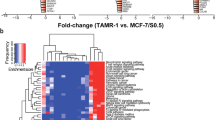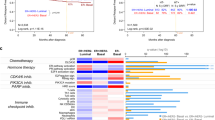Abstract
The EMS1 and CCND1 genes at chromosome 11q13 are amplified in about 15% of primary breast cancers but appear to confer different phenotypes in ER positive and ER negative tumours. Since there are no published data on EMS1 expression in large series of breast cancers we examined the relationship of EMS1 expression with EMS1 gene copy number and expression of mRNAs for cyclin D1 and ER. In a subset of 129 patients, where matched tumour RNA and DNA was available, EMS1 mRNA overexpression was associated predominantly with gene amplification (P=0.0061), whereas cyclin D1 mRNA overexpression was not (P=0.3142). In a more extensive series of 351 breast cancers, there was no correlation between cyclin D1 and EMS1 expression in the EMS1 and cyclin D1 overexpressors (P=0.3503). Although an association between EMS1 mRNA expression and ER positivity was evident (P=0.0232), when the samples were divided into quartiles of EMS1 or cyclin D1 mRNA expression, the increase in the proportion of ER positive tumours in the ascending EMS1 mRNA quartiles was not statistically significant (P=0.0951). In marked contrast there was a significant stepwise increase in ER positivity in ascending quartiles of cyclin D1 mRNA (P=0.030). A potential explanation for this difference was provided by the observation that in ER positive breast cancer cells oestradiol treatment resulted in increased cyclin D1 gene expression but was without effect on EMS1. The relationship between EMS1 expression and clinical outcome was examined in a subset of 234 patients with median follow-up of 74 months. High EMS1 expression was associated with age >50 years (P=0.0001), postmenopausal status (P=0.0008), lymph node negativity (P=0.019) and an apparent trend for worse prognosis in the ER negative subgroup. These data demonstrate that overexpression of EMS1 mRNA is largely due to EMS1 gene amplification, is independent of cyclin D1 and ER expression and, in contrast to cyclin D1, is not regulated by oestrogen. Independent overexpression of these genes may confer different phenotypes and disease outcomes in breast cancer as has been inferred from recent studies of EMS1 and CCND1 gene amplification.
This is a preview of subscription content, access via your institution
Access options
Subscribe to this journal
Receive 50 print issues and online access
$259.00 per year
only $5.18 per issue
Buy this article
- Purchase on Springer Link
- Instant access to full article PDF
Prices may be subject to local taxes which are calculated during checkout
Similar content being viewed by others
Author information
Authors and Affiliations
Rights and permissions
About this article
Cite this article
Hui, R., Ball, J., Macmillan, R. et al. EMS1 gene expression in primary breast cancer: relationship to cyclin D1 and oestrogen receptor expression and patient survival. Oncogene 17, 1053–1059 (1998). https://doi.org/10.1038/sj.onc.1202023
Received:
Revised:
Accepted:
Published:
Issue Date:
DOI: https://doi.org/10.1038/sj.onc.1202023
Keywords
This article is cited by
-
Endocytosis in cancer and cancer therapy
Nature Reviews Cancer (2023)
-
Aberrant Cyclin D1 splicing in cancer: from molecular mechanism to therapeutic modulation
Cell Death & Disease (2023)
-
PRMT5 promotes cancer cell migration and invasion through the E2F pathway
Cell Death & Disease (2020)
-
Overexpression and Tyr421-phosphorylation of cortactin is induced by three-dimensional spheroid culturing and contributes to migration and invasion of pancreatic ductal adenocarcinoma (PDAC) cells
Cancer Cell International (2019)
-
Wnt5a induces ROR1 to recruit cortactin to promote breast-cancer migration and metastasis
npj Breast Cancer (2019)



